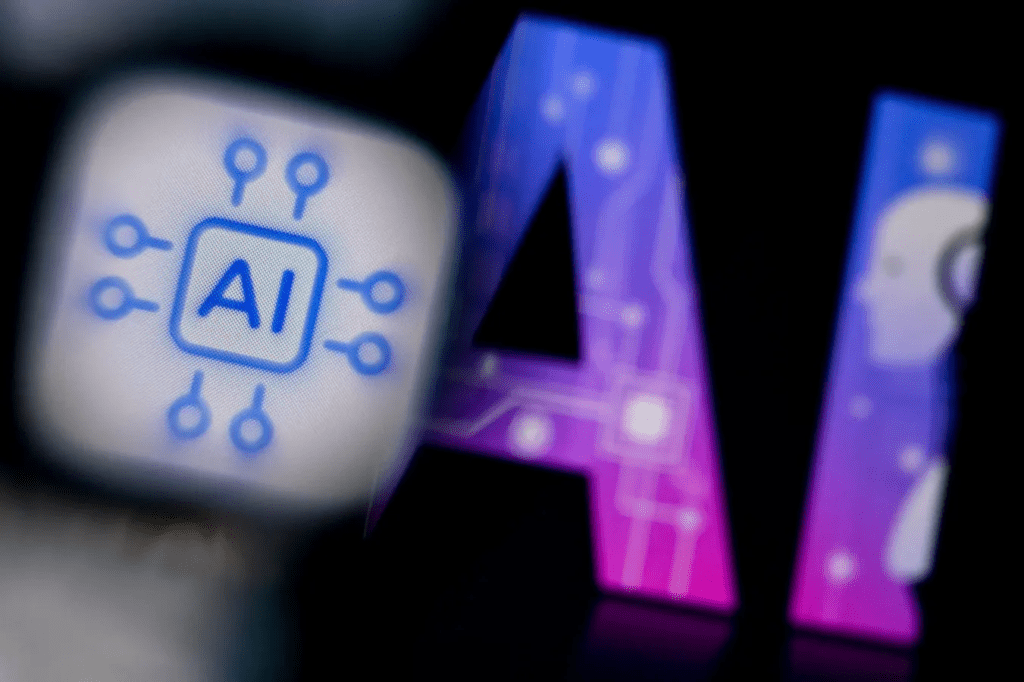Tech’s AI euphoria is fueling record valuations, trillion-dollar deals, and a new debate: is this innovation — or irrational exuberance 2.0?
The AI Boom Driving Markets Higher
All three major U.S. indexes ended October on a strong note, with the Dow up 0.8%, the S&P 500 +0.7%, and the Nasdaq +2.2% — capping a month dominated by Big Tech’s record-breaking AI investments and mixed earnings reactions.
As investors cheer near-record highs, Wall Street is split. Bulls see unstoppable growth from an AI-driven revolution; bears warn that valuations are “running far ahead of reality,” echoing the late-1990s dot-com bubble.
According to LPL Financial’s Jeff Buchbinder, the information-technology sector’s weight in the S&P 500 has surpassed 35% — an all-time high, reflecting just how concentrated the market has become in a handful of mega-cap names.
AI spending has driven roughly two-thirds of the S&P 500’s profit growth in Q3, and analysts now expect double-digit earnings growth in 2026 — almost entirely contingent on the continuation of this AI capex boom.


$350 Billion and Counting: The Megacap Spending Race
Microsoft (MSFT), Amazon (AMZN), Meta (META) and Alphabet (GOOGL) are on track to collectively spend $350 billion in 2025 on AI infrastructure — from data centers to GPU clusters — and have all raised their capital-expenditure guidance again.
This frenzy follows OpenAI’s $500 billion data-center partnership with Nvidia, and hundreds of billions more in AI-related supply-chain investments worldwide. UBS estimates total global AI spending will hit $375 billion this year, rising to $500 billion by 2026.
But even with that staggering figure, questions remain: will all this capex translate into long-term profitability, or are we simply replaying the script of over-investment seen before the 2000 crash?
The Case for a Bubble
Veteran economist David Rosenberg believes the answer is clear: “The market has been in a price bubble for over a year.”
He points to:
- Shiller P/E ratio rising above two standard deviations from its historical average in mid-2024.
- A need for 15% annual EPS growth through 2030 to justify today’s valuations — double the historical trend.
- The cyclical detachment between fundamentals and price action.
Rosenberg warns that even profitable names aren’t immune. “In the 1990s, Microsoft, Dell, Intel, and Cisco had real businesses and cash flow — yet they fell 60-80% when the bubble burst.”
Similarly, former Biden CEA chair Jared Bernstein told CNBC that the share of GDP devoted to AI investment is now one-third greater than the internet-related peak in 2000. He called the current situation “a textbook bubble — a vast gap between investment levels and credible expectations of future profit.”
He highlighted OpenAI’s $1 trillion in AI-related projects on just $13 billion in revenue, describing it as “a divergence between plausible future earnings and current capital allocation that certainly looks bubbly.”
Ben Inker of GMO Asset Management added that funding dynamics have grown dangerous:
“It’s one thing if Microsoft or Meta invests billions in data centers from cash flow.
But OpenAI and xAI don’t — they rely on debt and exotic financing from Nvidia and AMD.”
That shift, he said, is a hallmark of late-stage speculative behavior, where debt replaces cash as the fuel for growth.


The Counter-Argument: “It’s Different This Time”
Not everyone agrees that an AI crash is inevitable.
Jeff Buchbinder and Jeremiah Buckley of Janus Henderson argue that valuations, while elevated, are backed by fundamentals. Growth companies are not only more expensive but far more profitable than their value peers — a stark contrast to 1999.
Anneka Treon, ING Global Head of Wealth Management, told CNBC that AI spending equals roughly half of operating cash flows for megacaps, yet liquidity remains abundant:
“The runway of funding is long. You have easier monetary policy, easier fiscal policy, strong earnings, and a global capex boom.”
Larry Fink, CEO of BlackRock, dismissed the bubble narrative altogether:
“Investing in AI doesn’t just mean GPUs. It’s HVAC, IT networks, power grids, energy infrastructure. These are long-term national investments, not speculative bets.”
Fink compared the current build-out to a new industrial revolution, saying America must invest heavily “to remain the global leader in AI.”
Even Howard Marks of Oaktree Capital, known for his caution, doesn’t see full mania yet:
“Valuations are high, but not crazy. I don’t detect the psychological excess that defines true bubbles.”
To him, today’s environment resembles the early internet era — transformational, yet selective. Many companies will fail, but the survivors will reshape entire industries.
A Delayed Pop — or Just a Long Climb?
Former Intel CEO Pat Gelsinger says yes, there’s a bubble — but it won’t burst soon:
“We’re already in one. But it could last years. We’re displacing the entire internet infrastructure as we know it.”
He predicts the real payoff from AI won’t materialize until the late 2020s, meaning this hype cycle may keep expanding before any correction.


What’s Next for Investors
The next few quarters will test whether AI spending produces returns or merely inflates valuations.
Key things to watch:
- Capex trends: Do Microsoft, Amazon, Meta, and Google sustain their massive spending into 2026?
- Profit conversion: How much of AI investment actually lifts EPS and margins?
- Valuation metrics: Shiller P/E and price-to-book ratios remain stretched — any macro shock could trigger a correction.
- Debt exposure: As smaller AI players borrow heavily, liquidity risk could ripple through the ecosystem.
- Economic data: Upcoming ISM manufacturing, ADP employment, and ISM services reports will shape sentiment, especially amid corporate layoffs at Amazon (14,000 jobs) and UPS (48,000 cuts).
Market Implications
- Short-term: As long as earnings momentum holds and liquidity stays loose, AI-driven megacaps may continue powering indexes higher.
- Medium-term: If spending slows or profits disappoint, the valuation premium collapses, pulling the broader S&P 500 down with it.
- Long-term: The AI revolution is real — but not every company will survive it. As Larry Fink put it:
“We’ll have big winners and big losers. That’s capitalism.”
Yes — AI hype has all the ingredients of a bubble.
But unlike 2000, today’s giants have real revenue, cash, and global infrastructure. The danger lies not in fantasy, but in over-extrapolation — assuming infinite profit growth from finite innovation.
For investors, that means staying selective: own the leaders, avoid the leverage, and remember that even revolutions correct before they mature.
Disclosure: This article does not represent investment advice. The content and materials featured on this page are for educational purposes only.
Related: November is historically one of the stock market’s best months. Where to invest?










